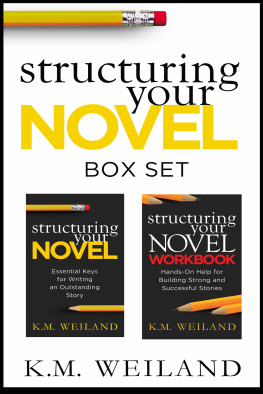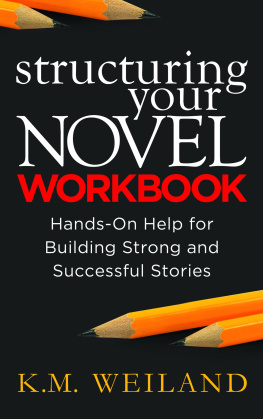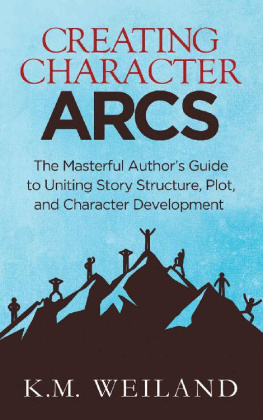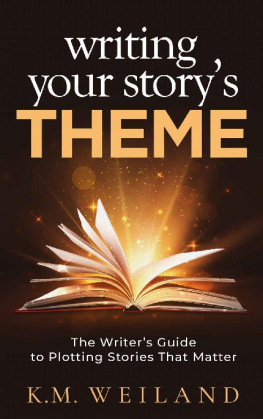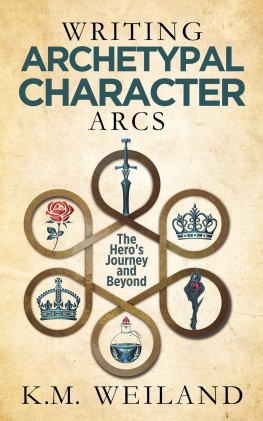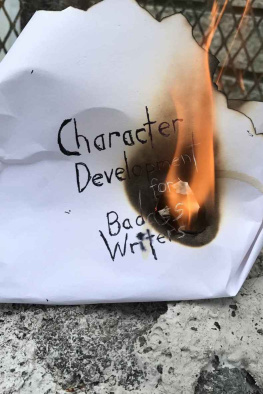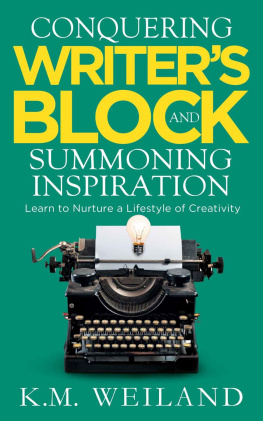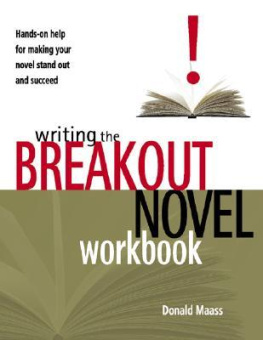Contents

Get a free copy of acclaimed author K.M. Weilands helpful book of character tips CRAFTING UNFORGETTABLE CHARACTERS.
Click here to get started:
https://www.kmweiland.com/free-characters-book/
Uncover the Secrets to Creating Characters Readers Will Never Forget
Award-winning author K.M. Weilands previous book, the acclaimed Creating Character Arcs showed writers how to identify the five most important types of character arcs and use them to bring your own characters to life with stunning and powerful realism.
Now its time to put those lessons to use! Building upon the principles youve already learned, Creating Character Arcs presents a guided approach to choosing the right type of character arc for your story, joining plot and character into a cohesive and resonant whole, and choosing stories with life-changing themes.
Containing hundreds of incisive questions and imagination-revving exercises, this valuable resource will show you how to:
- Write an inspiring Positive Change Arc
- Create one of three unforgettable Negative Change Arcs
- Take full advantage of a heroic Flat Arc
- Align the structure of your character arcs with that of your plot
- Revise a story that has no arc
This accessible and streamlined workbook will empower you to create resonant character arcsand an outstanding novel.
Start writing your best book today!
INTRODUCTION
WRITING A GREAT character, in itself, isnt enough to create a great story. If youre going to write a story worthy of that amazing character, the first thing you have to do is learn how to write character arcs that resonate with your readers and leave them gasping, cheering, or crying. Or all three.
As I discuss in my book Creating Character Arcs , How to write character arcs? isnt just any old question for a writer. Its one of the questions. Master the tenets of Positive Change Arcs, Flat Arcs, and Negative Change Arcs, and youll be able to write any story with confidence and skill.
Figuring out how to write character arcs takes your understanding of story far beyond that of just a character changing over the course of the story. It will take you beyond even the all-important foundation of story structure to the core principles of story theory (which Ive already talked about, in depth, in Structuring Your Novel and the Structuring Your Novel Workbook ).
Character evolution is at the heart of any good story. Whether its the protagonist doing the changing, or whether hes changing the world around him, character arcs are ultimately the whole point of fiction. The changethe journey from one spiritual/emotional/intellectual place to anotheris the story of humanity. As an author, your primary job is learning how those fundamental changes work in real life, and how you can then present them in your fiction with enough realism to connect with your readers.
Why Character Arcs Are Necessary to Transform Your Stories
Many writers struggle with the idea of plot vs. characterthe idea that these two elements of a story supposedly stand in opposition to one another, or perhaps even cancel each other out. You may hear certain writers claiming their stories are either plot-driven or character-drivenas if a story can be only one or the other.
But as youre about to discover, this is an utterly false paradigm.
Character and plot are, in fact, two sides of the same coin. They cannot exist without each other. The external plot/conflict exists to provide a dramatic visual metaphor for the characters inner conflict. The storys inner and outer conflicts must mutually drive one another, pushing and pulling in the perfect symmetry of a piston pumping back and forth. The character creates the plot, and the plot forges the character.
Even better, if you look closely, what you find nestled at the heart of these two symbiotic halves of your story is theme . Theme arises directly from the characters arc, as proven within the exterior plot. What your character wants throughout your story and the ways in which he changes to either obtain it or grow past it is what will ultimately prove what your story is about. This is what proves your storys theme.
What this means is that the characters inner journey or arc can actually be structured in harmony with the plot itself. By breaking your storys three acts down into its nine most salient moments and turning points (Hook, Inciting Event, First Plot Point, First Pinch Point, Second Plot Point/Midpoint, Second Pinch Point, Third Plot Point, Climax, Resolution), you can then use these moments to not just guide your characters arc, but to ensure it aligns perfectly with the external plot.
In Creating Character Arcs , I used this basic structural approach to identify and analyze five different types of arc. We find two positive arcsthe Positive Change Arc and Flat Arc. And we find three negative arcsthe Disillusionment Arc, Fall Arc, and Corruption Arc. Every single one of these arcs is based on the changes we all undergo or witness over and over again in real life. In learning to understand these universal psychological patterns, you can bring the resonance and power of realistic evolution to any type of story.
How to Use This Workbook
In this workbook, you will discover all of these principles, via step-by-step guides for crafting each important structural element and specific questions for narrowing your focus. If youre an outliner, you can use this workbook to help you plan powerful character arcs before you ever begin your first draft (the methods discussed here work hand in hand with those I teach in Outlining Your Novel , Structuring Your Novel , and their respective workbooks). You can also use the workbook to analyze an already completed manuscript, confirm its structural strengths, and identify its weaknesses.
Each chapter offers an introduction to the concepts discussed in the exercises, as well as examples from popular books and movies. I have also included a guide, at the end of each section, to help you locate the associated chapters in Creating Character Arcs . I recommend you start by reading that bookjust as you would a textbookbefore embarking on the workbook. You will understand the principles and their applicability better in context.
Each chapter of the workbook explores a different type of arc, from beginning to end. To determine which arc will be the best choice for your story, be sure to start with the section directly following this one: Choose Which Character Arc You Will Use.
Within each chapter, each section builds upon the next in a series of steps that will help you move from your character arcs big picture to the smaller details and back again. The more thorough you are in responding to each question and filling in each blank, the more prepared you will be to write or revise your novel. But dont hesitate to skip around. You may find youre unable to definitively answer some of the questions until youve first answered some of the later ones.
As with my previous two workbooks, I wanted to offer this one as an e-book as well as a paperback, since its a much more cost-efficient option than the hard copy. However, it is a bit of a different take on a workbook. You wont be able to write in your answers as you would otherwise. Instead, youll need to grab a notebook and write your answers to the questions and exercises there (which makes the workbook totally reusable!).
If you purchase the e-book version and decide its not working for you, for whatever reason, please feel free to request a refund. Most retail sellers will provide a full refund if you make your request within seven days of purchase. If youve missed that window, email me and Ill be happy to refund your full purchase price myself. My goal is to make the workbook as accessible and useful as possible. If the e-book format isnt working for you, then its not doing its job!


